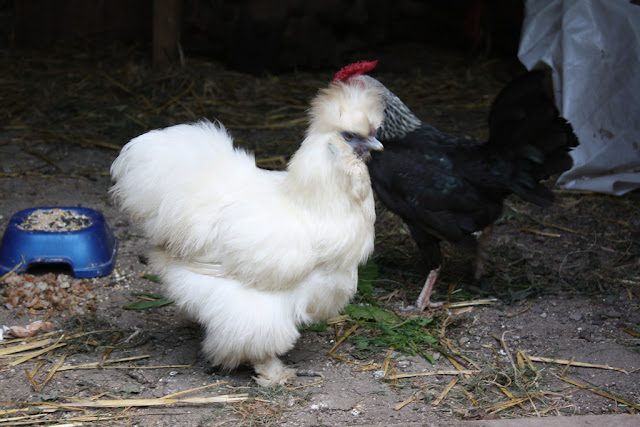The Silkie chicken is one of the most popular ornamental
chicken breeds today. Silkies are known for their incredibly friendly, pet-like
personality, which, combined with their unusual appearance, adds to their
appeal.
History
The origin of the Silkie hen is uncertain although they have
been around for several hundred years. It is thought that they originated in
India, China or Japan and they arrived in Europe around 200 years ago where
they were sold as crosses between rabbits and chickens! They are a lightweight
chicken with a broad, stout looking body which is covered in fine fluffy
feathers. They have short, rather ragged looking tails and the head is short
and neat with an upright and full crest. The beak is short and broad, the face
smooth and the eyes black and bright. The comb is circular and described as a
mulberry comb and the wattles are concave, semi circular and not particularly
long. The legs are purplish blue in colour and they have a fifth toe.
Behavior/Temperament
Silkie chicken is very calm, trusting and friendly. They are
unable to fly and can be kept easily with low fencing. They usually do little
or no damage to the garden if given them to access freely.
Silkie hens are not good layers. They lay a few cream or
tinted colored eggs. But they are great mothers, and go broody frequently. They
are even supremely happy to hatch the eggs of other birds. So they are
frequently used as foster mothers for other birds.
Some poultry fanciers consider Silkie hens as the ideal
organic incubator. Silkie hens cheerfully brood and raise their unorthodox
offspring too, if given the chance. The hens stop laying eggs during the summer
months.
The Silkie chicken should be kept in dry conditions, because
their feathers are not waterproof. The breed is extremely suitable as pets,
especially suitable for children. They are very cold hardy and also do well in
confinement.
The breed was valued as a medicinal food item because of its
black skin and bones. The average lifespan of Silkie chicken is around 9 years.
Color Varieties:
- White
- Buff
- Black
- Gray
- Blue
- Splash
- Partridge
- Lavender (not recognized by American Poultry Association)
- Cuckoo (not recognized by American Poultry Association)
Silkie chicken eggs - an unremarkable, standard light brown
colour. No - they're wonderful at sitting on eggs, but if you want a good
layer, don't have Silkies.
They will lay about 100 to 120 eggs each year.
They can stop laying altogether during the summer months.
Despite some information on the internet that blue-earlobed
chickens lay blue eggs - that's a myth - Sillkie eggs are a standard
creamy-brown colour.
Skin, Toes, and Earlobes:
Silkies have black skin and black bones. They are considered
a delicacy in many parts of Asia, and some cultures believe the meat has
healing properties. The meat of a silkie is a little darker than a standard
chicken and has a richer, gamier flavor.
Silkies have a polydactyly gene, which results in an extra
toe on each foot. This is a breed standard. Their extra toe appears on the back
of their leg, much like the dewclaw on a dog.
Silkie earlobes are shockingly bright and iridescent,
they’re colored turquoise or aquamarine.
Silkies : physical appearance
- Their characteristic downy feathers come in a multitude of colours including white, black, blue, grey, gold and porcelain.
- Silkies come in standard or 'Bearded' - the Bearded Silkie has a beard and muffs.
- All Silkies have a black face, bones and skin; the flesh is a very dark grey-blue.
- A Silkie's beak should be grey or grey-blue. Legs are feathered and underneath are grey.
- Feet are also grey, and a real Silkie has five toes.
- Earlobes should be a beautiful shade of bright turquoise blue.
- The wattles and comb should be black or a dark, mulberry shade - if it's red, it's not a full-bred Silkie.
- The 'walnut' (also known as 'cushion') comb is a feature.
Interesting Facts About the Silkie
They produce fewer eggs than most other breeds, averaging
90-120 per year. Their eggs range in color from white to light brown. Because
they are so broody, they make excellent setters, and are often used to hatch
other breeds’ eggs.
Silkies are calm, trusting, friendly, and docile. Because of
their temperament and because they’re flightless, they are often kept as family
pets. Silkies can become quite affectionate, but do require frequent, gentle
handling at first to socialize them to their “humans."
If You Like, then Please Share with Your Friends..



















No comments:
Post a Comment